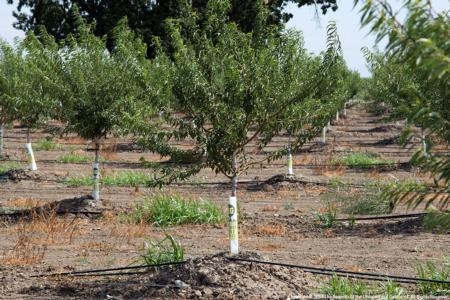UC scientists share national award for water conservation project
California's ongoing drought has made it even more critical for growers to get the most crop per drop of water used. Scientists from UC Division of Agriculture and Natural Resources and UC Davis and other land-grant universities were recently honored by USDA's National Institute of Food and Agriculture and the Association of Public and Land-Grant Universities for their years of research to help farmers better use microirrigation systems to sustainably irrigate their land.
The 2014 Experiment Station Section Excellence in Multistate Research Award presented by the Experiment Station Committee on Organization and Policy on Nov. 2 recognizes the universities' exceptional collaboration on a multistate research project.
Patrick Brown, professor in the Department of Plant Sciences at UC Davis, Jan Hopmans, professor in the Department of Land, Air and Water Resources at UC Davis, Larry Schwankl, UC Cooperative Extension specialist emeritus, and Ken Shackel, professor in the Department of Plant Sciences at UC Davis, are the UC researchers participating in the project “Microirrigation for Sustainable Water Use.”
"The Multistate Research Program is one of the best kept secrets of the land-grant university system, and this award recognizes outstanding interdependent efforts of researchers and extension specialists that have come together to tackle a priority issue that no one institution can address on their own,” said H. Michael Harrington, executive director of the Western Association of Agricultural Experiment Station Directors. “This microirrigation project was selected out of more than 300 multistate projects because, since 1972, the group has made major advances in sustainable agriculture and water conservation.”
Using more precise irrigation management, California growers have increased water use efficiency on processing tomatoes by 54 percent and on almonds by 33 percent since 1990.
Conventional irrigation systems that apply high volumes of water over wide areas can lose a lot of water through runoff, wind, or evaporation. As a result, conventional irrigation systems often over water or under water plants. Instead, microirrigation, or drip, systems use special timers, sensors, and a network of narrow tubes to deliver the right amount of water at the right time.
In the last five years, the group's research has led to new microirrigation equipment and tools that are easier to install, more durable, and more precise. These advances, along with engagement with farmers, have encouraged adoption of microirrigation systems, which has led to significant economic and environmental impacts.
“As director of USDA-NIFA, my goal is to ensure the science we invest in leads to solutions to today's most pressing challenges,” said Sonny Ramaswamy. “One of those challenges is finding ways to feed the growing population while minimally impacting the environment. A safe, reliable supply of water is inextricably linked to food security. The five-fold increase in irrigated acres that took place during the 20th century cannot be repeated in the 21st century — there isn't the space. Instead, we must increase efficiency of the irrigated farmland we have, and that is what this project is doing.”
In addition to UC, other participating land-grant institutions include Auburn University, University of Arizona, Colorado State University, University of Florida, University of Hawaii, University of Idaho, Iowa State University, Kansas State University, Mississippi State University, University of Nebraska, New Mexico State University, Cornell University, Oregon State University, University of Puerto Rico, Texas A&M AgriLife Research, University of the Virgin Islands, Washington State University, and University of Wyoming. The universities collaborated with the USDA's Natural Resources Conservation Service and Agricultural Research Service.
The award was presented by ESCOP chair Bob Shulstad and Ramaswamy at the Association of Public and Land-Grant Universities annual meeting in Orlando, Fla.
The project's name will be added to a plaque at the USDA Waterfront Centre in Washington, D.C., and the group will receive $15,000 to support their ongoing work. The group's continued efforts are more critical than ever as the U.S. continues to experience extreme droughts that threaten water supplies and crops that depend on irrigation.
These efforts are supported, in part, through USDA-NIFA by the Multistate Research Fund, established in 1998 by the Agricultural Research, Extension, and Education Reform Act (an amendment to the Hatch Act of 1888) to encourage and enhance multistate, multidisciplinary agricultural research on critical issues. Additional funds were provided by contracts and grants to participating scientists. For more information about the microirrigation project, visit http://www.cropinfo.net/MI.

